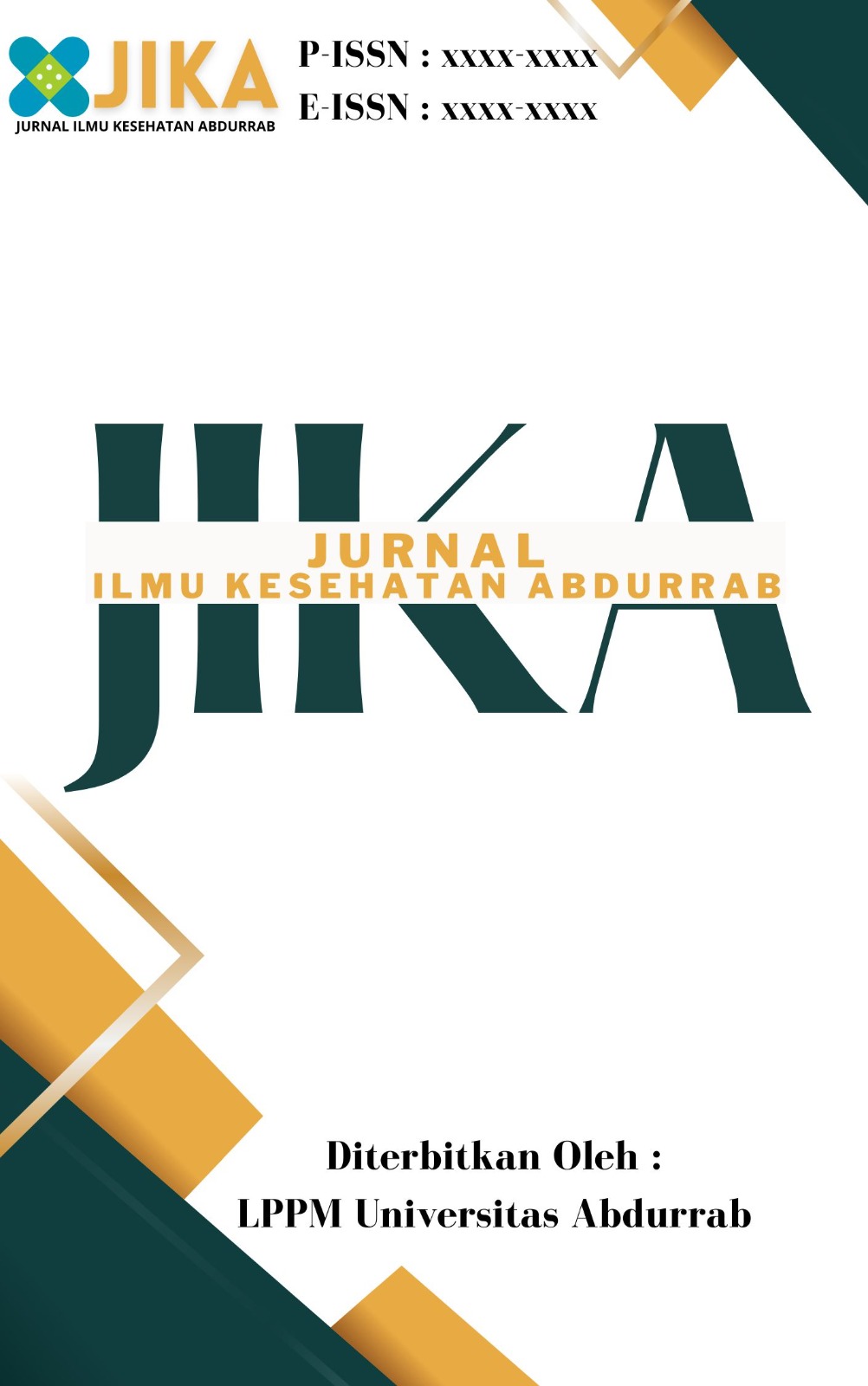Formulation of Cream Preparation from Stem Bark of the Menteng (Baccaurea racemosa) Extract
Keywords:
Extract, CreamAbstract
Stem bark of the menteng (Baccaurea racemosa) contains antioxidant phenolic and flavonoid compounds capable of stopping free radical chain reactions. This research aims to make a formula for cream preparation and to find out the antioxidant activity of cream extract from the stem bark of the menteng (Baccaurea racemosa). The study used experimental methods to make a 96% ethanol extract cream with concentrations of 0,5%, 1,5%, and 3%. The results of a semisolid shaped organoleptic test with a typical fragrance of brown, brown, and old brown brown bark extract, homogenity tests F0, F1, F2, and F3, are homogeneous. The pH tests F0 (5), F1 (4,5), F2 (4,7) and F3 (4,8). The spreadability tests F0 (6,2 cm), F1 (6,1 cm), F2 (5,9 cm) and F3 (5,6 cm). Viscosity tests F0 (887,73 cPs), F1 (748,06 cPs), F2 (839,43cPs) and F3 (817,03cPs). Testing antioxidant activity using UV-Vis spectroscopic photometers obtained a wavelength of 516,80 nm with an absorption value of 0,725 in formula 1 (extract concentration of 0,5%) obtained an IC50 value of 51,41, in formula 2 (extract concentration of 1,5%) obtained an IC50 value of 63,43, and in formula 3 (extract concentration of 3%) obtained an IC50 value of 48,91. The antioxidant content of formulas 1 and 2 has strong antioxidant activity whereas formula 3 has a significant amount of antioxidant activity.
Downloads
References
Trihono PP, Alatas H, Tambunan T, Pardede SO. Tata Laksana Sindrom Nefrotik Idiopatik Pada Anak [Internet]. Vol. 20, Unit Kerja Koordinasi Nefrologi IKatan Dokter anaK IndoNesIa KONSENSUS. 2016. 349–352 p. Available from:https://doi.org/10.1016/j.kint.2 019.09.033%0Ahttp://dx.doi.org/10.1016/S01406736(14)605419%0Ahttp://www.kdigo.org/clinical_practice_guidelines/pdf/KDIGOGNGuideline.pdf%0Ahttp://ejournal.unsrat.ac.id
Jerome C. Lane. Pediatric Nephrotic Syndrome [Internet]. Medscape. 2020.Available from: https://emedicine.medscape.com/arti cle/982920-overview
Tapia C, Bashir K. Nephrotic Syndrome [Internet]. StatsPearls Publishing. 2022.Available from: https://www.ncbi.nlm.nih.gov/books/NBK470444/
Downie ML, Gallibois C, Parekh RS, Noone DG. Nephrotic syndrome in infants and children: Pathophysiology and management. Paediatr Int Child Health [Internet].2017;37(4):24858.Availab lefrom:http://doi.org/10.1080/20469 047.2017.1374003
Bergstein JM. Nelson: Ilmu Kesehatan Anak, Vol. 3. 15th ed. Jakarta: Penerbit Buku Kedokteran EGC; 2000.
Siregar RS. Atlas Berwarna: Saripati Penyakit Kulit. 2nd ed. Jakarta: Penerbit Buku Kedokteran EGC; 2005.
Shukla S. Tinea Corporis [Internet]. Medscape. 2020. Available from: https://emedicine.medscape.com/arti cle/1091473-overview Yee G, Aboud AM Al. Tinea Corporis [Internet]. ncbi. 2020. Available from:https://www.ncbi.nlm.nih.gov/books/NBK544360/
Djuanda S. Ilmu Penyakit Kulit dan Kelamin. Jakarta: Balai Penerbit FKUI;2007.42
K. J. Marcdante, R. M.Kliegman, H. B.Jenson and R. E.Behrman, Nelson Ilmu Kesehatan Anak Esensial. Ikatan Dokter Anak Indonesia. ed ke-6, Saunders Elsevier, 2011.
Downloads
Published
How to Cite
Issue
Section
License
Please find the rights and licenses in Jurnal Ilmu Kesehatan Abdurrab. By submitting the article/manuscript of the article, the author(s) accept this policy.
1. License
The non-commercial use of the article will be governed by the Creative Commons Attribution license as currently displayed on Creative Commons Attribution-NonCommercial-ShareAlike 4.0 International License.
2. Author’s Warranties
The author warrants that the article is original, written by stated author(s), has not been published before, contains no unlawful statements, does not infringe the rights of others, is subject to copyright that is vested exclusively in the author and free of any third party rights, and that any necessary written permissions to quote from other sources have been obtained by the author(s).
3. User Rights
Jurnal Ilmu Kesehatan Abdurrab spirit is to disseminate articles published are as free as possible. Under the Creative Commons license, Jurnal Ilmu Kesehatan Abdurrab permits users to copy, distribute, display, and perform the work for non-commercial purposes only. Users will also need to attribute authors and Jurnal Ilmu Kesehatan Abdurrab on distributing works in the journal.
4. Rights of Authors
Authors retain all their rights to the published works, such as (but not limited to) the following rights;
- Copyright and other proprietary rights relating to the article, such as patent rights,
- The right to use the substance of the article in own future works, including lectures and books,
- The right to reproduce the article for own purposes,
- The right to self-archive the article,
- The right to enter into separate, additional contractual arrangements for the non-exclusive distribution of the article's published version (e.g., post it to an institutional repository or publish it in a book), with an acknowledgment of its initial publication in this journal (Jurnal Ilmu Kesehatan Abdurrab).
5. Co-Authorship
If the article was jointly prepared by other authors, any authors submitting the manuscript warrants that he/she has been authorized by all co-authors to be agreed on this copyright and license notice (agreement) on their behalf, and agrees to inform his/her co-authors of the terms of this policy. Jurnal Ilmu Kesehatan Abdurrab will not be held liable for anything that may arise due to the author(s) internal dispute. Jurnal Ilmu Kesehatan Abdurrab will only communicate with the corresponding author.
6. Royalties
This agreement entitles the author to no royalties or other fees. To such extent as legally permissible, the author waives his or her right to collect royalties relative to the article in respect of any use of the article by Jurnal Ilmu Kesehatan Abdurrab.
7. Miscellaneous
Jurnal Ilmu Kesehatan Abdurrab will publish the article (or have it published) in the journal if the article’s editorial process is successfully completed. Jurnal Ilmu Kesehatan Abdurrab's editors may modify the article to a style of punctuation, spelling, capitalization, referencing and usage that deems appropriate. The author acknowledges that the article may be published so that it will be publicly accessible and such access will be free of charge for the readers as mentioned in point 3.







